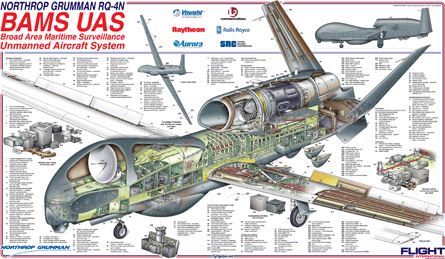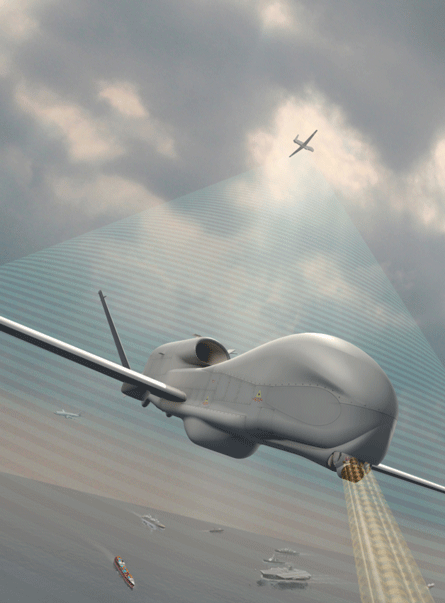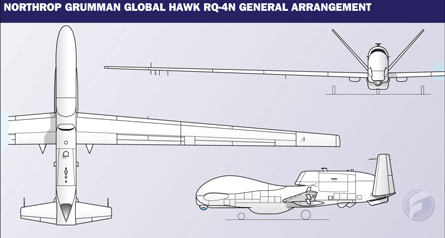The US Navy was the slowest and perhaps most reluctant of the armed services to embrace the potential of unmanned aircraft for the purpose of persistent surveillance.
After a false start in 2003, the USN initiated a competitive procurement process for a Broad Area Maritime Surveillance (BAMS) fleet in 2006. The multi-billion dollar contract predictably drew wide and intense interest from industry, affording the USN's selection team an unusually wide array of options.
From Boeing/Gulfstream's G550 business jet derivative, Lockheed Martin/General Atomics' medium-altitude Mariner turboprop to Northrop Grumman's high-altitude RQ-4N Global Hawk unmanned air vehicle, the USN selected the latter in March 2008.
|
|---|
© Northrop GrummanThe BAMS requirement called for a 360° sensor for electronic transmissions |
And patience brought reward for the USN in the form of a mature aircraft production and mission system now in development that easily beats the capabilities of the most advanced surveillance aircraft in operation.
The RQ-4N, also under consideration by Australia, is a derivative of the RQ-4B Block 30 Global Hawk ordered by the US Air Force. Externally, the similarities greatly outnumber the differences between the two airframes. The unmanned aircraft is powered by the same Rolls-Royce AE3007 engine that also propels the Embraer ERJ-145 regional jet, among other manned aircraft. The Global Hawk's distinctive V-tail and inverted-spoon nose also are retained for the maritime role.
But the outward comparisons mask profound changes below the surface. The RQ-4N's maritime surveillance mission requires a wholesale change of equipment from the overland patrol mission of the RQ-4B. It is not only a matter of sensor payloads. The different operating profiles between the aircraft require adding safety of flight gear for the control surfaces.
"Because the navy has a requirement to come down out of altitude and come below the clouds, look for ships and get deck movement, and things like that, we've incorporated a commercial off-the-shelf anti-icing system on the inlet of the engine much like what's on the ERJ-145," says Tom Twomey, Global Hawk navy business development manager.
Another de-icing system, US Federal Aviation Administration-approved and made by New York state-based Cox, is being installed on the vertical tails and on the wing.
"It's also going to be the same system on the [Boeing] P-8A that they're going to use on their vertical and horizontal stabilisers to be able to go down and fly around in icing conditions," Twomey says.
The USAF operates the RQ-4B fleet at high altitude throughout the flight, but the USN's definition of the BAMS role will require greater flexibility. It will not be enough to detect and identify targets at high altitude, particularly in cloudy weather that obscures camera visibility. The RQ-4N will be asked to dive to low altitude to get a closer look at the decks of suspicious ships.
The USN has designated the BAMS fleet as an adjunct to the Lockheed Martin P-3C Orion and its manned successor - the Boeing P-8A. The manned fleet will detect submarine activity, using sonobuoys and torpedoes. But the manned aircraft will have a secondary role in anti-surface warfare, being cued by the BAMS aircraft to intercept hostile or suspicious ships.
Weaponising the RQ-4N is an option unlikely to be adopted, despite the aircraft's provisions for stores on each wing. "You have hundreds of other airplanes that can drop bombs, so it doesn't make sense to put that system in. It just adds cost and weight. [The RQ-4N] is there to be an intelligence, surveillance and reconnaissance sensor," Twomey says.
Click on the image to see a larger version |
While the de-icing equipment reflects the USN's desire for an aircraft that can make frequent altitude adjustments, the RQ-4N's payload reflects the diverse requirements of navigating and patrolling the world's oceans.
The array of communications channels on board the RQ-4N easily dwarfs those on the USAF system. The USAF controls the RQ-4B from the ground using a commercial Ku-band satellite link. Although expedient for the service's overland patrol mission, commercial satellite links for the over-water mission are impractical. Instead, the USN will use Ka-band Wideband Gapfiller satellites for the control link, which provides superior communications coverage over the oceans.
Beyond the control link, the BAMS mission also requires a plethora of tactical communications gear. Two common datalinks - Ku-band and X-band - will be mounted on either side of the fuselage, allowing the aircraft to function as a communications relay between the P-8A, other aircraft and the fleet.
"That changes the paradigm of maritime surveillance from going out and surveying an area and coming back and distilling the data and getting it to the people who essentially use it, to a real-time data feed. You know exactly where ships are at all times," Twomey says.
Finally, the communications payload will add Link 16 to communicate with P-8s, ships and fighters. The aircraft will also feature multiple UHF and VHF radios with Have Quick and Singars capability.
By far the most important sensor aboard the aircraft is the least understood. The Northrop Grumman multifunction active sensor, an active electronically scanned array, emerged for the first time as part of the BAMS proposal.
LONG LEGACY
But the sensor has a long legacy, dating to the APY-6 X-Band synthetic aperture radar and ground moving target indicator developed for the Lockheed NP-3C Hairy Buffalo, Twomey says. The multifunction active sensor is also based on elements from the Office of Naval Research's real-time precision targeting radar development programme.
"They've been bringing this along for years and years. And we really put a lot of human capital and brain power into picking this sensor," Twomey says.
The adoption of the multifunction active sensor will mean another tweak to the RQ-4's outer-mould line. The belly-mounted radome will be slightly rounder for the multifunction active sensor than for the RQ-4B's enhanced integrated sensor suite. In addition, the multifunction active sensor has a 360° coverage array compared with the enhanced integrated sensor suite's side-looking antenna.
 |
|---|
"With a mechanically scanned array you have to stop the radar, you have to stop the scan and drill down and do an inverse synthetic aperture picture of each one of those targets," Twomey says. "With an active electronically scanned array radar you're able to do what we call track while scan. You're able to track hundreds of targets and do multiple reconnaissance at the same time. So it will easily handle high-target densities like the straits of Malacca, where there are hundreds of ships, and provide target ID and geo-location of targets."
Northrop selected its proprietary multifunction active sensor system over other suppliers, including RQ-4B enhanced integrated sensor suite supplier Raytheon. The multifunction active sensor system was untested, but Northrop developed a prototype for test flights on a Gulfstream II testbed.
"We wanted to show that this was not a PowerPoint radar. This was hardware. We could get empirical data," Twomey says. "We gave them the data and the imagery, maritime targets, overland synthetic aperture radar, inverse synthetic aperture radars of ships. So there is a bit of development to do on this to get it to a production system, but we're a lot farther on than a PowerPoint [file]."
For the news BAMS fleet, the task of detecting ships will not be limited to radar imagery alone. The ships themselves can alert the RQ-4N to their location inadvertently by way of their electronic emissions.
ELECTRONIC SUPPORT MEASURES
Northrop experimented with its proprietary LR-100 electronic support measures suite during the USN's Global Hawk Maritime Demonstration - a proof-of-concept process that has recently been renamed the BAMS Demonstration programme. The side-looking LR-100, however, proved insufficient for the USN's needs. Instead, the BAMS requirement called for a 360° sensor for electronic transmissions stretching 555km (300nm) in any direction.
For the competition, Northrop selected Sierra Nevada's Merlin electronic support measures system. "It's a sensor that will give you relatively good [directional finding] accuracy, provides specific emitter identifications and is able to do target identification," Twomey says. "This is a more capable system [than the LR-100] and better suited to the BAMS requirements. That's why it was chosen and the customer seems very happy with it."
The Raytheon-supplied ground control station for the RQ-4N is likely to appear entirely conventional at first glance, filled with Dell or Gateway-branded screens and keyboards. But Northrop's concept promises the USN customer a new level of flexibility. Using non-propriety hardware, such as the keyboard and mouse to control the aircraft, and software identical to the USAF system, the USN will be able to adapt the system through software updates.
"The joint mission planning system -- and all these applications that are currently out there and that the navy has funded and is using for other systems - are going to lie resident on this system," Twomey says.
The nature of the BAMS requirement also introduces a major change in how the USN will conduct the maritime patrol mission. The communications links between the RQ-4N and other aircraft, surface and ground systems will allow for the first time an immediate response to airborne surveillance contacts.
Indeed, the USN is considering changing the name of the ground stations from tactical support centres to tactical operations centres.
"Because now they'll be getting data real time, they won't be waiting for the airplane to land," Twomey says. "The airplane will be over the target and they'll be analysing the information real time."
Source: Flight International

























